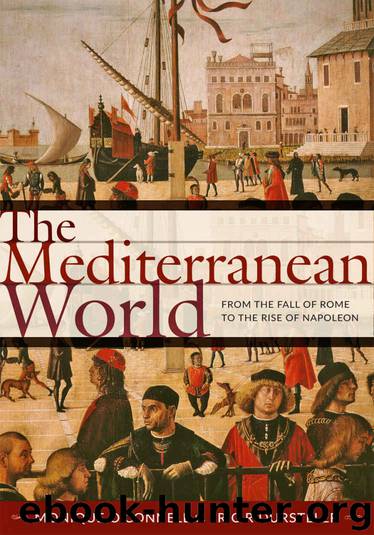The Mediterranean World by Monique O'Connell & Eric R Dursteler

Author:Monique O'Connell & Eric R Dursteler [O'Connell, Monique]
Language: eng
Format: epub
Publisher: Johns Hopkins University Press
Published: 2016-05-14T22:00:00+00:00
Giuliano Sangallo’s drawing of Cyriac of Ancona’s now-lost sketch of Hagia Sophia, Constantinople. Vatican Apostolic Library
The Aragonese and the Angevins both had ambitions for a pan-Mediterranean empire, and the two remained locked in a struggle for preeminence in the early fourteenth century. The Aragonese monarchy was fragmented into several regions ruled by separate branches of the royal dynasty: Aragon itself, Majorca, and Sicily each had its own king. Within the Iberian kingdom of Aragon, the regions of Aragon, Catalonia, and Valencia shared a single monarch but were distinct in law and administration. Each region had its own parliament, or cortes, responsible for local privileges and matters of taxation. During the course of the fourteenth century, Aragonese control of Sicily weakened, leaving the Sicilian barons with nearly independent fiefdoms and little centralized control to stop private disputes between barons from turning to civil war. The barons allied and fought under the factional labels of Latin and Catalan, indicating the powerful foreign influences that controlled the island.
The Angevin king of Naples, Robert “the Wise,” managed a series of diplomatic and marital alliances that reached outward in all directions. To the east, the Albanian Thopia family supported Angevin claims there, and in the Peloponnese, the Angevins enforced their authority in Achaia. Robert’s granddaughter and heiress, Joanna, married Andrew of Hungary, building a trans-Adriatic alliance. To the west, Robert’s own marriages to Yolanda of Aragon and Sancia of Majorca were intended to consolidate the Angevin position in Sicily and the western Mediterranean. Robert mounted multiple expeditions against Sicily, in 1314 and again from 1330 to 1343, but none of these short-term victories turned into long-term occupations.
Robert was deeply involved in the political struggles of northern Italy due to three factors: the papacy’s absence from Rome, Neapolitan financial dependence on Florentine banking houses, and the factional rivalries that divided and defined political life in Italian towns. The permanent residency of the popes in the southern French city of Avignon began with Clement V, elected in 1305, whose close relationship with the king of France and poor health kept him from ever visiting Rome. In the pope’s absence, Robert became the de facto leader of the papal party in Italy, called the Guelfs. The opposing faction, the Ghibellines, supported the German Holy Roman emperor’s claims to authority on the peninsula. Guelfs and Ghibellines battled for control of civic institutions across northern Italy, and Robert was often drawn into these disputes, as the example of Genoa demonstrates. Conflicts between Genoa’s noble families were extraordinarily bitter and constantly threatened to undermine the city’s overseas trade. In 1311 the strife-weary Genoese handed themselves over to the Holy Roman emperor Henry VII, enraging the Guelfs among the population and sparking a civil war after Henry’s death, in 1313. By 1317 the Genoese Guelf faction was in control and gave the city to Robert’s protection, a lordship that lasted until 1335.
Robert’s involvement in Tuscany was driven not only by factional conflict but also by culture and by his connections with the Bardi and Peruzzi banking houses of Florence.
Download
This site does not store any files on its server. We only index and link to content provided by other sites. Please contact the content providers to delete copyright contents if any and email us, we'll remove relevant links or contents immediately.
| Africa | Americas |
| Arctic & Antarctica | Asia |
| Australia & Oceania | Europe |
| Middle East | Russia |
| United States | World |
| Ancient Civilizations | Military |
| Historical Study & Educational Resources |
Empire of the Sikhs by Patwant Singh(22767)
The Wind in My Hair by Masih Alinejad(4843)
The Templars by Dan Jones(4558)
Rise and Kill First by Ronen Bergman(4545)
The Rape of Nanking by Iris Chang(4023)
12 Strong by Doug Stanton(3419)
Blood and Sand by Alex Von Tunzelmann(3056)
The History of Jihad: From Muhammad to ISIS by Spencer Robert(2506)
Babylon's Ark by Lawrence Anthony(2432)
The Turkish Psychedelic Explosion by Daniel Spicer(2245)
Gideon's Spies: The Secret History of the Mossad by Gordon Thomas(2236)
No Room for Small Dreams by Shimon Peres(2235)
Inside the Middle East by Avi Melamed(2230)
Arabs by Eugene Rogan(2193)
The First Muslim The Story of Muhammad by Lesley Hazleton(2154)
Bus on Jaffa Road by Mike Kelly(2035)
Come, Tell Me How You Live by Mallowan Agatha Christie(2027)
Kabul 1841-42: Battle Story by Edmund Yorke(1921)
1453 by Roger Crowley(1880)
